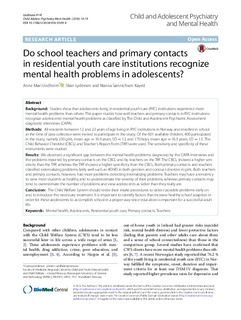| dc.contributor.author | Undheim, Anne Mari | |
| dc.contributor.author | Lydersen, Stian | |
| dc.contributor.author | Kayed, Nanna Sønnichsen | |
| dc.date.accessioned | 2016-06-30T09:16:01Z | |
| dc.date.accessioned | 2016-07-01T07:00:43Z | |
| dc.date.available | 2016-06-30T09:16:01Z | |
| dc.date.available | 2016-07-01T07:00:43Z | |
| dc.date.issued | 2016 | |
| dc.identifier.citation | Child and Adolescent Psychiatry and Mental Health 2016, 10(19):1-11 | nb_NO |
| dc.identifier.issn | 1753-2000 | |
| dc.identifier.uri | http://hdl.handle.net/11250/2395117 | |
| dc.description.abstract | Background
Studies show that adolescents living in residential youth care (RYC) institutions experience more mental health problems than others. This paper studies how well teachers and primary contacts in RYC institutions recognize adolescents’ mental health problems as classified by The Child and Adolescent Psychiatric Assessment diagnostic interviews (CAPA).
Methods
All residents between 12 and 23 years of age living in RYC institutions in Norway and enrolled in school at the time of data collection were invited to participate in the study. Of the 601 available children, 400 participated in the study, namely 230 girls, mean age = 16.9 years, SD = 1.2 and 170 boys, mean age = 16.5 years, SD = 1.5. The Child Behavior Checklist (CBCL) and Teacher’s Report Form (TRF) were used. The sensitivity and specificity of these instruments were studied.
Results
We observed a significant gap between the mental health problems diagnosed by the CAPA interviews and the problems reported by primary contacts on the CBCL and by teachers on the TRF. The CBCL showed a higher sensitivity than the TRF, whereas the TRF showed a higher specificity than the CBCL. Both primary contacts and teachers classified externalizing problems fairly well such as ADHD in both genders and conduct disorder in girls. Both teachers and primary contacts, however, had more problems detecting internalizing problems. Teachers may have a tendency to view most students as healthy and to underestimate the severity of their problems, whereas primary contacts may tend to overestimate the number of problems and view adolescents as sicker than they really are.
Conclusion
The Child Welfare System should revise their intake procedures to detect possible problems early on and to introduce the necessary treatment. It is important to identify factors that increase healthy school adaption in order for these adolescents to accomplish school in a proper way since education is important for a successful adult life. | nb_NO |
| dc.language.iso | eng | nb_NO |
| dc.publisher | BioMed Central | nb_NO |
| dc.rights.uri | https://creativecommons.org/licenses/by/4.0/ | |
| dc.subject | Mental health, Adolescents, Residential youth care, Primary contacts, Teachers | nb_NO |
| dc.title | Do school teachers and primary contacts in residential youth care institutions recognize mental health problems in adolescents? | nb_NO |
| dc.type | Journal article | nb_NO |
| dc.type | Peer reviewed | nb_NO |
| dc.date.updated | 2016-06-30T09:16:01Z | |
| dc.source.volume | 10 | nb_NO |
| dc.source.journal | Child and Adolescent Psychiatry and Mental Health | nb_NO |
| dc.source.issue | 19 | nb_NO |
| dc.identifier.doi | 10.1186/s13034-016-0109-4 | |
| dc.identifier.cristin | 1365247 | |
| dc.description.localcode | © 2016 The Author(s). This article is distributed under the terms of the Creative Commons Attribution 4.0 International License ( http://creativecommons.org/licenses/by/4.0/ ), which permits unrestricted use, distribution, and reproduction in any medium, provided you give appropriate credit to the original author(s) and the source, provide a link to the Creative Commons license, and indicate if changes were made. The Creative Commons Public Domain Dedication waiver ( http://creativecommons.org/ publicdomain/zero/1.0/ ) applies to the data made available in this article, unless otherwise state | nb_NO |

